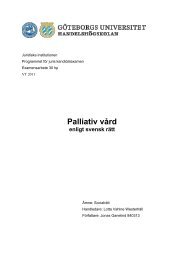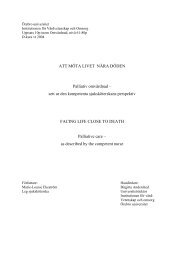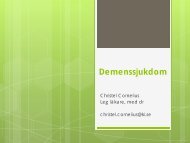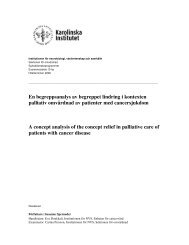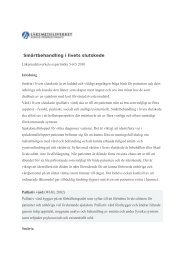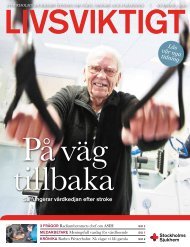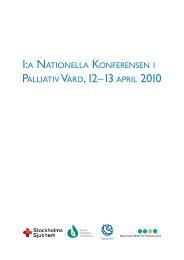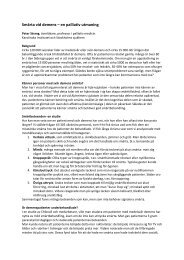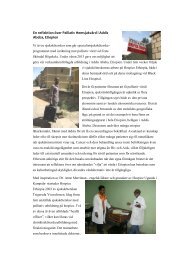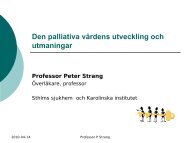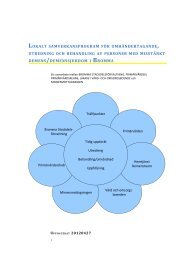Physiotherapy in palliative careâ - Stockholms sjukhem
Physiotherapy in palliative careâ - Stockholms sjukhem
Physiotherapy in palliative careâ - Stockholms sjukhem
Create successful ePaper yourself
Turn your PDF publications into a flip-book with our unique Google optimized e-Paper software.
Compression of the vertebrae affect<strong>in</strong>g the sp<strong>in</strong>eMetastasis of the vertebrae can cause problems when there is pressure on a nerve root and withcompression of the sp<strong>in</strong>e. If there is a spontaneous fracture of the vertebrae the compression ofthe sp<strong>in</strong>e is often <strong>in</strong>creased and could result <strong>in</strong> paralysis. The surgical treatment aims atlessen<strong>in</strong>g pressure on the medulla through clean<strong>in</strong>g the vertebrae or through a lam<strong>in</strong>ectomyafter which the sp<strong>in</strong>e is stabilized with a spl<strong>in</strong>t. The most common symptom of compression ofthe sp<strong>in</strong>e is pa<strong>in</strong> <strong>in</strong> the back where the metastasis is located. Pa<strong>in</strong> can also radiate from thenerve root of the segment that is damaged. The pa<strong>in</strong> follows the segment of the dermatome.Other symptoms like ataxia, reduction of feel<strong>in</strong>g of sensitivity and of motor movements arepresent.It is important that the patient is mobilized early after surgical treatment to avoid complicationsfrom ly<strong>in</strong>g <strong>in</strong> bed. The exercises consist of tra<strong>in</strong><strong>in</strong>g stability of the torso, orthostatic tra<strong>in</strong><strong>in</strong>g andmov<strong>in</strong>g exercises and they should be customized accord<strong>in</strong>g to the level of the <strong>in</strong>jury and afterthe function of the patient follow<strong>in</strong>g surgery. (14) Much of the tra<strong>in</strong><strong>in</strong>g used for other patientswith sp<strong>in</strong>al <strong>in</strong>juries can be used also for these patients. The difference be<strong>in</strong>g, that aftermobiliz<strong>in</strong>g follow<strong>in</strong>g a pathological fracture, difference <strong>in</strong> pa<strong>in</strong> pattern and that the illness itselfand ongo<strong>in</strong>g treatment can affect the general condition of the patient and h<strong>in</strong>der mobilization.Pa<strong>in</strong>- reliev<strong>in</strong>g treatment like with TENS and acupuncture, can also be of help when the patienthas pa<strong>in</strong> from metastases of the skeleton. (14)Other severe symptoms that can be treated by a physiotherapistFatigueEverybody can relate to tiredness. Most of us have at some time felt totally exhausted andwithout energy and that can most often be cured with rest and a good night’s sleep. People withcancer can describe an unusual and extreme tiredness which does not disappear after rest<strong>in</strong>g orsleep<strong>in</strong>g. They feel as tired when they wake up as when they go to bed. The tiredness is felt likea chronic feel<strong>in</strong>g of unpleasantness, lack of energy, lack of concentration and forgetfulness. Inhealth care the term fatigue is used for this experience, a word that can be found <strong>in</strong> the Englishand French language but has no equivalent <strong>in</strong> the Swedish language. When speak<strong>in</strong>g with apatient the words tiredness or weakness is often used. (15)<strong>Physiotherapy</strong> <strong>in</strong> <strong>palliative</strong> care – a cl<strong>in</strong>ical handbook Ulla Frymark, Lilian Hallgren, Ann‐Charlotte Reisberg 16



